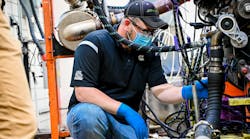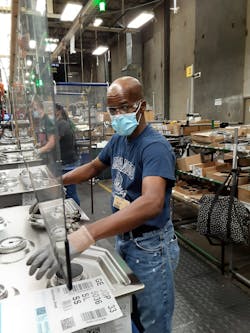It’s often said that a person’s true nature is revealed by the way they handle a crisis. The same could be said of a company.
Trust, empathy, transparency and strong communication skills are sought-after personal traits and important building blocks of company culture. When the pandemic hit, those building blocks became even more important, setting the stage for a new relationship between employees and employers.
“It was principles, not processes that were front and center for us,” explains Thomas Quick, vice president, human resources, for GE Appliances, a Haier company.
GEA leaders organized their actions around three core goals: protecting their people, serving their customers and supporting their communities.
Employee safety came first. GEA closed its plants for a week to outfit plants with the necessary equipment to meet safety protocols.
“Imagine the task at hand to completely change standard work and implement new safety processes across nine enormous plants in one week’s time,” says Quick. “We gave the overall direction to our teams but let them determine how best to implement and then shared best practices as we continuously learned and adapted.”
GEA used an obeya approach (war-room meetings that are a part of lean) “to align cross-functional leaders to ensure we run to these principles on a daily basis,” explains Quick. Leaders also prepared and ran possible scenarios with their teams early on, using a framework by the advisory firm Gartner. “It’s all about guiding principles and then trusting our teams,” Quick adds.
Building a Foundation of Trust
Trusting teams, and the individuals who make up those teams, was also a key pandemic approach for Cummins Inc., the engine and generator manufacturing company based in Columbus, Indiana.
“We created two senior-level teams,” explains Lorrie Meyer, Cummins’ vice president of talent and organizational development. “One was to eliminate operational risk and manage the day-to-day processes to handle the pandemic, and the other was to look at the long-term strategy. We looked at what our vision should be for the new normal and what strategies we need to deliver that vision.”
Best practices were regularly shared, via video for employees working remotely, to push collaboration even further. It helped that team efforts have long been core to the Cummins culture, and it was a natural extension to push collaboration even further.
Meyer points out that the company had to evolve in thinking about how people do their jobs. Managers had to focus more specifically on the results of the work instead of the workday schedule.
“If you are working at 10 p.m. rather than at 10 a.m. because you have to help your child with school, that isn’t the important factor—it’s whether that work gets done,” Meyer says.
Talking openly about employees’ specific needs and accommodating those needs made the team relationships even stronger. “We have shown that our workforce and company cannot only adapt but thrive when everyone is given the support they need to make the best decisions for their circumstances,” Meyer says.
Looking at the needs of employees outside of the physical location has both employees and employers viewing the working landscape differently.
Ann Feyerherm, associate dean and professor of organizational theory and management at Pepperdine University, says that in leadership circles, talk of a “psychosocial contract” is trending. In general, this refers to an unwritten set of expectations that employees have of their company. These expectations change with the times, or as new generations enter the workforce.
In this moment, explains Feyerherm, “companies need to ask what policies will increase engagement for employees that are not all under one roof or need flexible work schedules at physical locations. This might be a new way of thinking for some companies who hadn’t faced this situation, and it’s a new way for employees to evaluate their companies.”
Breaking Boundaries
In addition to having to rearrange procedures to address the safety issues of the pandemic, GEA was in a unique position in that the pandemic also increased the need for its products. There was a jump in demand, and employees were able to break some boundaries when it came to job duties.
“More than 1,100 managers and headquarters employees volunteered to work our assembly lines to address pandemic staffing pressures in our plants,” Quick says.
When production employees had to take time off to manage their personal lives early in the pandemic, it created staffing pressures. This resulted in non-production, salaried employees working more than 150,000 hours on assembly lines or taking on other responsibilities outside of their normal jobs, such as manning temperature check stations around the clock.
Quick makes a point of explaining that the company was able to ramp up quickly due to the strength of its existing structure. “Our volunteers wouldn’t have been able to take on those jobs if we hadn’t had standardized work in place as part of our lean transformation,” he says.
This experience is something the company can build on. “Those salaried workers who went on the line garnered a lot of respect from the workers on the line,” says Quick. And this will lead to innovation going forward, Quick believes, due to collaboration and understanding of different jobs.
FirstBuild, another part of GEA’s business, also jumped in to meet the present need. Early on, GEA wasn’t able to procure face shields due to the enormous need. FirstBuild, which is an innovation micro-factory for quickly prototyping new ideas, began producing the shields. FirstBuild was so proficient in making shields that it not only supplied employees but also donated 15,000 to hospitals across the region. That action was clearly aligned with the company’s guiding principle of focusing on the community.
Another effort was the creation of a program called GEA 4 Heroes that involved donating appliances to 2,000 front-line healthcare workers and first responders in almost every state.
In the midst of all this, the headquarters community of Louisville, Kentucky, got an economic boost, as in December 2020 the company announced a new $80 million dishwasher manufacturing line at its supersite, creating 280 jobs.
Constant Communication
A key component to meeting all of these challenges was a very thorough communications program. Kevin Nolan, CEO at GEA, held weekly video calls to keep communication flowing. Virtual townhalls provided a forum to answer questions that constantly arose.
In fact, the increase in the methods and frequency of communication has led GEA to re-evaluate some traditions. The company’s annual leadership meeting, which was only open to executives, is now open to all employees.
Cummins also increased its transparency around business operations. Leaders talked to employees about customer demand and challenges in the supply chain and informed the workforce about how all these issues were being handled. Communicating virtually with employees across a variety of locations has led Cummins to view its workforce strategies differently moving forward. Evaluating the physical location of employees wasn’t something that Cummins had been focused on.
“I think a year ago we had some questions about how working virtually would impact our company, but we have been successful and that has widened our view,” says Meyer. “We were able to deliver for our people, our customers and our stakeholders, and can approach the future from an expanded vision.
“Having to convert many processes to a virtual platform caused us to think more about how we can tap into talent that is generally based at our headquarters. This new view also helps our current employees, as we can offer them more opportunities to expand their career opportunities if location isn’t an issue.”
Quick said that GEA will have more flexible schedules going forward and that flexibility includes, like Cummins, hiring outside of their headquarters location. “This is a new attitude for us,” says Quick, “but something we are very excited about.”
A Clear Future
The exact characteristics—trust, openness, and innovative thinking—that have led these two companies to adapt and survive during the pandemic, are the very same cultural components that contribute to an even stronger relationship between employers and employees.
“Companies that are successful have a clarity of purpose,” says Feyerherm. “And this continues as they deal with COVID-19. Their actions flow from this clarity and this gives the organization, and specifically employees, a clear purpose.”
To illustrate, Feyerherm offers an example given by former Miami Heat Coach Pat Riley during a speech she attended in her early career in manufacturing. Riley explained that an organization is like an orange. When you squeeze an orange, what comes out is the result of the many processes that had to be done correctly, such as the right soil, right nutrients and having been tended carefully. So, like an orange, what is squeezed out of an organization during stressful times reflects everything that has been done to create the company.
A strong organization, with a well-defined culture and clarity of purpose in times of crisis, will invariably cause a rededication on the part of both employers and employees to strengthen their commitment.
“People don’t leave something they are committed to,” says Feyerherm. “If the right values and cultures are in place, this new psychosocial contract can thrive and be the standard for the future.”





